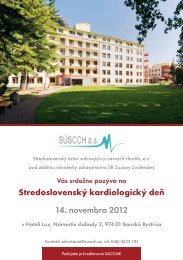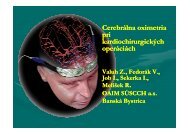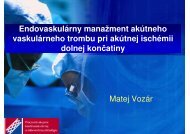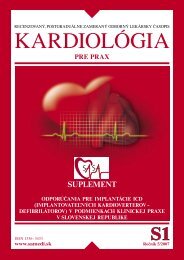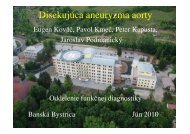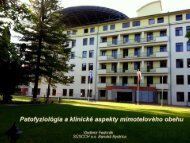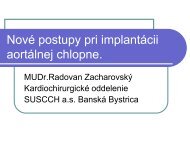Management of acute myocardial infarction in patients presenting ...
Management of acute myocardial infarction in patients presenting ...
Management of acute myocardial infarction in patients presenting ...
You also want an ePaper? Increase the reach of your titles
YUMPU automatically turns print PDFs into web optimized ePapers that Google loves.
ESC Guidel<strong>in</strong>es 2917<br />
Different reperfusion strategies are depicted <strong>in</strong> Figure 2. In this<br />
figure the first medical contact is the place (ambulance or hospital)<br />
where, at least <strong>in</strong> pr<strong>in</strong>ciple, reperfusion therapy could be given. The<br />
(<strong>in</strong>creas<strong>in</strong>g) time limits for the different reperfusion strategies are<br />
also depicted schematically.<br />
a. Percutaneous coronary <strong>in</strong>terventions<br />
The role <strong>of</strong> PCIs dur<strong>in</strong>g the early hours <strong>of</strong> STEMI can be divided<br />
<strong>in</strong>to primary PCI, PCI comb<strong>in</strong>ed with pharmacological reperfusion<br />
therapy (facilitated PCI), and ‘rescue PCI’ after failed pharmacological<br />
reperfusion. Separate ESC Guidel<strong>in</strong>es cover<strong>in</strong>g all <strong>in</strong>dications<br />
for PCI have been published before. 26<br />
Primary PCI and delay times<br />
Primary PCI is def<strong>in</strong>ed as angioplasty and/or stent<strong>in</strong>g without prior<br />
or concomitant fibr<strong>in</strong>olytic therapy, and is the preferred therapeutic<br />
option when it can be performed expeditiously by an<br />
experienced team (Table 5). An experienced team <strong>in</strong>cludes not<br />
only <strong>in</strong>terventional cardiologists but also skilled support<strong>in</strong>g staff.<br />
This means that only hospitals with an established <strong>in</strong>terventional<br />
cardiology programme (24 h/7 days) should use primary PCI as a<br />
rout<strong>in</strong>e treatment option for <strong>patients</strong> present<strong>in</strong>g with the symptoms<br />
and signs <strong>of</strong> STEMI. Lower mortality rates among <strong>patients</strong><br />
undergo<strong>in</strong>g primary PCI are observed <strong>in</strong> centres with a high<br />
volume <strong>of</strong> PCI procedures. 27,28 Primary PCI is effective <strong>in</strong> secur<strong>in</strong>g<br />
and ma<strong>in</strong>ta<strong>in</strong><strong>in</strong>g coronary artery patency and avoids some <strong>of</strong> the<br />
bleed<strong>in</strong>g risks <strong>of</strong> fibr<strong>in</strong>olysis. Randomized cl<strong>in</strong>ical trials compar<strong>in</strong>g<br />
timely performed primary PCI with <strong>in</strong>-hospital fibr<strong>in</strong>olytic<br />
therapy <strong>in</strong> high-volume, experienced centres have shown more<br />
effective restoration <strong>of</strong> patency, less reocclusion, improved residual<br />
left ventricular (LV), function and better cl<strong>in</strong>ical outcome with<br />
primary PCI. 29 Rout<strong>in</strong>e coronary stent implantation <strong>in</strong> <strong>patients</strong><br />
with STEMI decreases the need for target vessel revascularization<br />
but is not associated with significant reductions <strong>in</strong> death or re<strong><strong>in</strong>farction</strong><br />
rates 30,31 when compared with primary angioplasty. In<br />
addition, several randomized cl<strong>in</strong>ical trials with medium-term<br />
follow-up, <strong>in</strong>clud<strong>in</strong>g <strong>patients</strong> with STEMI, have shown that<br />
drug-elut<strong>in</strong>g stents reduce the risk <strong>of</strong> re<strong>in</strong>tervention compared<br />
with bare metal stents, without hav<strong>in</strong>g a significant impact on the<br />
risk <strong>of</strong> stent thrombosis, recurrent <strong>myocardial</strong> <strong><strong>in</strong>farction</strong>, and<br />
death. 32 – 34 As for other cl<strong>in</strong>ical presentations <strong>of</strong> coronary artery<br />
disease, long-term data on the efficacy and safety <strong>of</strong> drug-elut<strong>in</strong>g<br />
stents <strong>in</strong> <strong>patients</strong> with STEMI are still needed.<br />
Both randomized studies and registries have <strong>in</strong>dicated that long<br />
delay times to primary PCI are associated with a worse cl<strong>in</strong>ical<br />
outcome. 35,36 Several delay times can be def<strong>in</strong>ed: time from<br />
symptom onset to first medical contact (FMC), time from FMC<br />
to arrival <strong>in</strong> cath lab, time from FMC to sheath <strong>in</strong>sertion, time<br />
from FMC to balloon <strong>in</strong>flation. The ‘PCI-related delay time’ is<br />
the theoretical difference between the time <strong>of</strong> FMC to balloon<br />
<strong>in</strong>flation m<strong>in</strong>us the time from FMC to start <strong>of</strong> fibr<strong>in</strong>olytic therapy<br />
(¼ ‘door-to-balloon’ m<strong>in</strong>us ‘door-to-needle’). The extent to<br />
which the PCI-related time delay dim<strong>in</strong>ishes the advantages <strong>of</strong><br />
PCI over fibr<strong>in</strong>olysis has been the subject <strong>of</strong> many analyses and<br />
debates. Because no specifically designed study has addressed<br />
this issue, caution is needed when <strong>in</strong>terpret<strong>in</strong>g the results <strong>of</strong><br />
these post hoc analyses. From randomized trials it was calculated<br />
that the PCI-related time delay that may mitigate the benefit <strong>of</strong><br />
the mechanical <strong>in</strong>tervention varies between 60 37 and 110 m<strong>in</strong> 38<br />
depend<strong>in</strong>g on the fibr<strong>in</strong>olytic used. 39 In another analysis <strong>of</strong> these<br />
trials, a benefit <strong>of</strong> primary PCI over fibr<strong>in</strong>olytic therapy up to a<br />
PCI-related delay <strong>of</strong> 120 m<strong>in</strong> was calculated. 40 In 192 509 <strong>patients</strong><br />
<strong>in</strong>cluded <strong>in</strong> the NRMI 2-4 registry, 41 the mean PCI-related time<br />
delay where mortality rates <strong>of</strong> the two reperfusion strategies<br />
were equal was calculated at 114 m<strong>in</strong>. This study also <strong>in</strong>dicated<br />
that this time delay varied considerably accord<strong>in</strong>g to age,<br />
symptom duration, and <strong>in</strong>farct location: from ,1 h for an anterior<br />
<strong><strong>in</strong>farction</strong> <strong>in</strong> a patient ,65 years present<strong>in</strong>g ,2 h after symptom<br />
onset, to almost 3 h for a non-anterior <strong><strong>in</strong>farction</strong> <strong>in</strong> a patient<br />
.65 years present<strong>in</strong>g .2 h after symptom onset. Although<br />
these results were derived from a post hoc analysis <strong>of</strong> a registry<br />
and reported delay times are sometimes <strong>in</strong>accurate, this study<br />
suggests that an <strong>in</strong>dividualized rather than a uniform approach<br />
for select<strong>in</strong>g the optimal reperfusion modality could be more<br />
appropriate when PCI cannot be performed with<strong>in</strong> a short delay.<br />
Tak<strong>in</strong>g <strong>in</strong>to account the studies and registries mentioned above,<br />
primary PCI (balloon <strong>in</strong>flation) should be performed with<strong>in</strong> 2 h<br />
after FMC <strong>in</strong> all cases. In <strong>patients</strong> present<strong>in</strong>g early with a large<br />
amount <strong>of</strong> myocardium at risk, the delay should be shorter.<br />
Although no specific studies have been performed, a maximum<br />
delay <strong>of</strong> only 90 m<strong>in</strong> after FMC seems to be a reasonable recommendation<br />
<strong>in</strong> these <strong>patients</strong>.<br />
Patients with contra<strong>in</strong>dications to fibr<strong>in</strong>olytic therapy have a<br />
higher morbidity and mortality than those eligible for this<br />
therapy. Primary PCI can be performed with success <strong>in</strong> these<br />
<strong>patients</strong>. 42 Primary PCI is the preferred treatment for <strong>patients</strong> <strong>in</strong><br />
shock. 43 Except for <strong>patients</strong> <strong>in</strong> cardiogenic shock, only the<br />
culprit lesion should be dilated <strong>in</strong> the <strong>acute</strong> sett<strong>in</strong>g. Complete<br />
revascularization <strong>of</strong> the non-culprit lesions may be performed at<br />
a later time po<strong>in</strong>t depend<strong>in</strong>g on the rema<strong>in</strong><strong>in</strong>g ischaemia.<br />
Facilitated PCI<br />
Facilitated PCI is def<strong>in</strong>ed as a pharmacological reperfusion treatment<br />
delivered prior to a planned PCI, <strong>in</strong> order to bridge the<br />
PCI-related time delay. Full-dose lytic therapy, half-dose lytic<br />
therapy with a glycoprote<strong>in</strong> (GP)IIb/IIIa <strong>in</strong>hibitor and GPIIb/IIIa<br />
<strong>in</strong>hibitor alone have been tested for this <strong>in</strong>dication. There is no evidence<br />
<strong>of</strong> a significant cl<strong>in</strong>ical benefit with any <strong>of</strong> these<br />
agents. 16,12,44,45 In spite <strong>of</strong> the fact that pre-PCI patency rates<br />
were higher with lytic-based treatments, no mortality benefit but<br />
more bleed<strong>in</strong>g complications were observed. The pre-PCI<br />
patency rates with upfront abciximab or high-bolus dose tir<strong>of</strong>iban<br />
alone were not higher than with placebo. Facilitated PCI as it has<br />
been tested <strong>in</strong> these trials cannot be recommended.<br />
Rescue PCI<br />
Rescue PCI is def<strong>in</strong>ed as PCI performed on a coronary artery which<br />
rema<strong>in</strong>s occluded despite fibr<strong>in</strong>olytic therapy. The non-<strong>in</strong>vasive<br />
identification <strong>of</strong> failed fibr<strong>in</strong>olysis rema<strong>in</strong>s a challeng<strong>in</strong>g issue, but<br />
,50% ST-segment resolution <strong>in</strong> the lead(s) with the highest<br />
ST-segment elevations 60–90 m<strong>in</strong> after start <strong>of</strong> fibr<strong>in</strong>olytic<br />
therapy has <strong>in</strong>creas<strong>in</strong>gly been used as a surrogate. Rescue PCI has<br />
been shown to be feasible and relatively safe. In a randomized<br />
study <strong>of</strong> 427 <strong>patients</strong> (REACT), the event-free survival at



